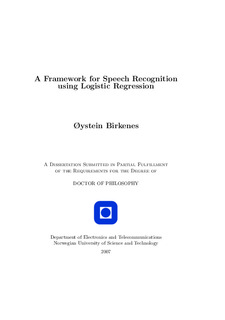| dc.contributor.advisor | Johnsen, Magne Hallstein | nb_NO |
| dc.contributor.advisor | Myrvoll, Tor Andre | nb_NO |
| dc.contributor.author | Birkenes, Øystein | nb_NO |
| dc.date.accessioned | 2014-12-19T13:29:27Z | |
| dc.date.available | 2014-12-19T13:29:27Z | |
| dc.date.created | 2007-08-06 | nb_NO |
| dc.date.issued | 2007 | nb_NO |
| dc.identifier | 122563 | nb_NO |
| dc.identifier.isbn | 978-82-471-3621-8 | nb_NO |
| dc.identifier.uri | http://hdl.handle.net/11250/249711 | |
| dc.description.abstract | Although discriminative approaches like the support vector machine or logistic regression have had great success in many pattern recognition application, they have only achieved limited success in speech recognition. Two of the difficulties often encountered include 1) speech signals typically have variable lengths, and 2) speech recognition is a sequence labeling problem, where each spoken utterance corresponds to a sequence of words or phones.
In this thesis, we present a framework for automatic speech recognition using logistic regression. We solve the difficulty of variable length speech signals by including a mapping in the logistic regression framework that transforms each speech signal into a fixed-dimensional vector. The mapping is defined either explicitly with a set of hidden Markov models (HMMs) for the use in penalized logistic regression (PLR), or implicitly through a sequence kernel to be used with kernel logistic regression (KLR). Unlike previous work that has used HMMs in combination with a discriminative classification approach, we jointly optimize the logistic regression parameters and the HMM parameters using a penalized likelihood criterion.
Experiments show that joint optimization improves the recognition accuracy significantly. The sequence kernel we present is motivated by the dynamic time warping (DTW) distance between two feature vector sequences. Instead of considering only the optimal alignment path, we sum up the contributions from all alignment paths. Preliminary experiments with the sequence kernel show promising results.
A two-step approach is used for handling the sequence labeling problem. In the first step, a set of HMMs is used to generate an N-best list of sentence hypotheses for a spoken utterance. In the second step, these sentence hypotheses are rescored using logistic regression on the segments in the N-best list. A garbage class is introduced in the logistic regression framework in order to get reliable probability estimates for the segments in the N-best lists. We present results on both a connected digit recognition task and a continuous phone recognition task. | nb_NO |
| dc.language | eng | nb_NO |
| dc.publisher | Fakultet for informasjonsteknologi, matematikk og elektroteknikk | nb_NO |
| dc.relation.ispartofseries | Doktoravhandlinger ved NTNU, 1503-8181; 2007:165 | nb_NO |
| dc.subject | Automatic speech recognition | en_GB |
| dc.subject | TECHNOLOGY: Information technology: Signal processing | en_GB |
| dc.title | A Framework for Speech Recognition using Logistic Regression | nb_NO |
| dc.type | Doctoral thesis | nb_NO |
| dc.source.pagenumber | 114 | nb_NO |
| dc.contributor.department | Norges teknisk-naturvitenskapelige universitet, Fakultet for informasjonsteknologi, matematikk og elektroteknikk | nb_NO |
| dc.description.degree | PhD i elektronteknikk | nb_NO |
| dc.description.degree | PhD in Electrical Engineering | en_GB |
